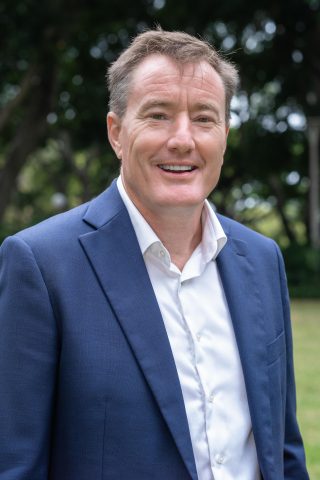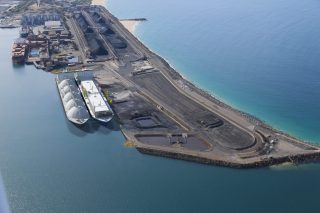As one of the nation's leading renewables operators and developers, Andrew Forrest's Squadron Energy was always expected to play a significant role in the transformation of Australia's energy grid.
Even so, when Dr Forrest promised last year to deliver one-third of the required expansion in the national renewable energy target from 40% to 82% by 2030, the numbers were astonishingly large - about $20bn for Squadron's pipeline of renewable and storage projects.
While there were early hopes in some parts of the industry for a smooth transition, they began to fade amid growing opposition in affected regional communities, the disorderly retirement of coal-fired generators, and projects falling behind schedule.
Through it all, however, Squadron's ambition has not faltered.

"With mounting closures and increasing outages of ageing coal-fired power plants, we can't afford to be distracted; now is the time to stay the course," chief executive Rob Wheals said.
"Building out variable renewable energy generation, backed up by batteries and flexible gas, will deliver the lowest-cost new build energy option.
"To not continue this journey would waste billions of dollars in investment, place our energy security at risk, and deny a huge opportunity to share economic development across many regional communities of Australia."
Squadron, which is part of the Forrest family's Tattarang group of companies, became one of the nation's biggest renewable energy players in December 2022 with the $4.2bn purchase of CWP Renewables.
The expanded group has 1.1GW of renewable energy in operation, and will be the biggest single contributor to helping Australia meet its 2030 target of 82 per cent renewable energy.
Two wind farms under construction - Uungula in the Central-West Orana Renewable Energy Zone in NSW and Clarke Creek Wind Farm located 150km north-west of Rockhampton in Queensland – will deliver about 900MW of capacity into the National Electricity Market.
They are in addition to Squadron's five wind farms in operation, and an expansive east-coast development pipeline of wind, solar and battery projects.
The company's plans also extend to gas, albeit in a restricted role to support renewables in periods of peak electricity demand (called "peaking") and complement variable wind and solar generation (called "firming").
In its submission to the Federal Government's Future Gas Strategy, Squadron said gas-powered generation in times of low renewable output would become critical.
While other stored energy sources such as batteries and pumped hydro could also provide firming capacity, Squadron said the limited duration of current battery technology and the delivery risks of pumped hydro "present commercial challenges and limit their full contribution at present".
The company had therefore invested in an LNG import terminal at Port Kembla in NSW, which was scheduled for completion by the end of the year.

"(Port Kembla) is the only solution capable of fixing our ongoing domestic gas supply issues," Mr Wheals said.
"It will address gas supply shortages on the east coast and supply gas to flexible gas peaking plants, which will firm renewable energy generation.
"Our pipeline of wind, solar and storage projects will enable us to provide 90-95% renewable energy, with our firming projects like Port Kembla Energy Terminal and Dubbo Firming Power Station helping us to supply the remaining 5%."
Another way of putting it, Squadron's submission said, was that gas-powered generation was a flexible energy source capable of speedy deployment with lower emissions than coal.
It would therefore help to avoid significant delay in exiting coal, as well as reduce emissions, until zero-emissions technology such as long-duration battery storage is more readily available.
Amid rising concern about large renewables projects in communities which were keen to preserve their character, Mr Wheals said it was critical to earn the support of the local population.
Squadron asked the Regional Australia Institute (RAI) to model the potential social and economic impact of the energy transition from 2024 to 2030.
The RAI found the benefits were significant, with projects forecast to create 6400 full-time equivalent jobs across Australia by 2030, mainly in the construction, engineering and professional design industries.
"But it's the supply chain flow-on effects that make an even bigger difference," Mr Wheals said.
"Outside of directly working for renewables companies, there will be another 7600 jobs in industries like transport and manufacturing, and the consumption created in the regions - with more people working and living locally - creates another 5700 jobs.
"All up, the modelling shows a net gain of almost 20,000 jobs.
"So we need to ensure regional communities are at the heart of the opportunity and that we invest not just the money but also the time to ensure that these once-in-a-generation benefits are realised and shared across the country."
The Squadron boss said the latest Electricity Statement of Opportunities (ESOO) from the Australian Energy Market Operator (AEMO) was a "welcome confirmation" that the energy transition was well underway.
The ESOO, which considers a range of outlooks when forecasting the electricity outlook for the next 10 years, found that if all expected investments to generate, store and transport electricity were delivered on time and in full, reliability could be managed over most of the next decade.
While short-term reliability had been improved, AEMO said it was tendering for off-market reserves in Victoria, NSW and South Australia this summer to cover potential shortfalls.
On the upside, Mr Wheals said there was a strong commitment from the banking sector to support renewable energy projects and the energy transition more broadly.
"As projects get larger and more complex, it is increasingly important to have a supportive lender group that is willing to work with us to find solutions and optimise funding structures to ensure a best-for-project approach," he said.
"It's great to see NAB recognised as Australia's leading bank for project finance to the global renewable energy sector after committing over $16.8 billion globally since 2003. (1)
"We were also very pleased that NAB's 200th global renewable energy transaction was our own Uungula Wind Farm, which was the only wind farm to reach financial close in Australia in 2023."
Right now, however, the country was "at a crossroads", looking ahead at the amount of renewable energy it needed to deploy by 2050.
"The heavy lifting has to happen over this next decade to achieve our net-zero goals," Mr Wheals said.
(1) NAB ranked as the number one Australian bank for global renewables transactions – Rankings based on IJGlobal League Table MLA, Renewables, both cumulative data from 1 January 2010 to 30 September 2023 and for the 9 months ending 30 September 2023.
NAB's $16.8bn in renewable energy financing supports clean energy projects across different technologies including solar PV, onshore and offshore wind, biomass, hydro, geo-thermal generation and battery storage assets around the world.
The information contained in this article is based upon sources believed to be reliable but which have not been independently verified. Opinions or ideas expressed may not necessarily be those of National Australia Bank Limited (NAB) nor may they necessarily reflect NAB's views or endorsement. This article is for informational purposes only.






